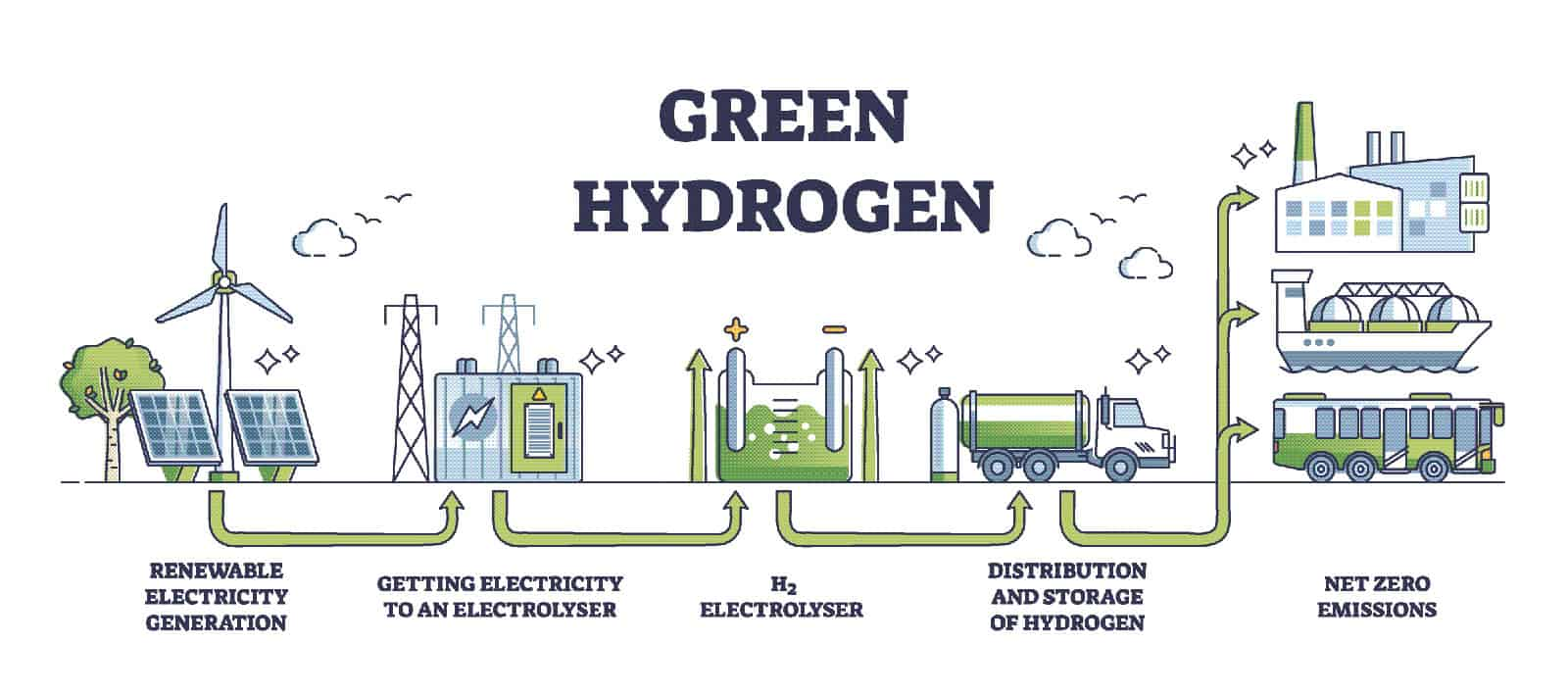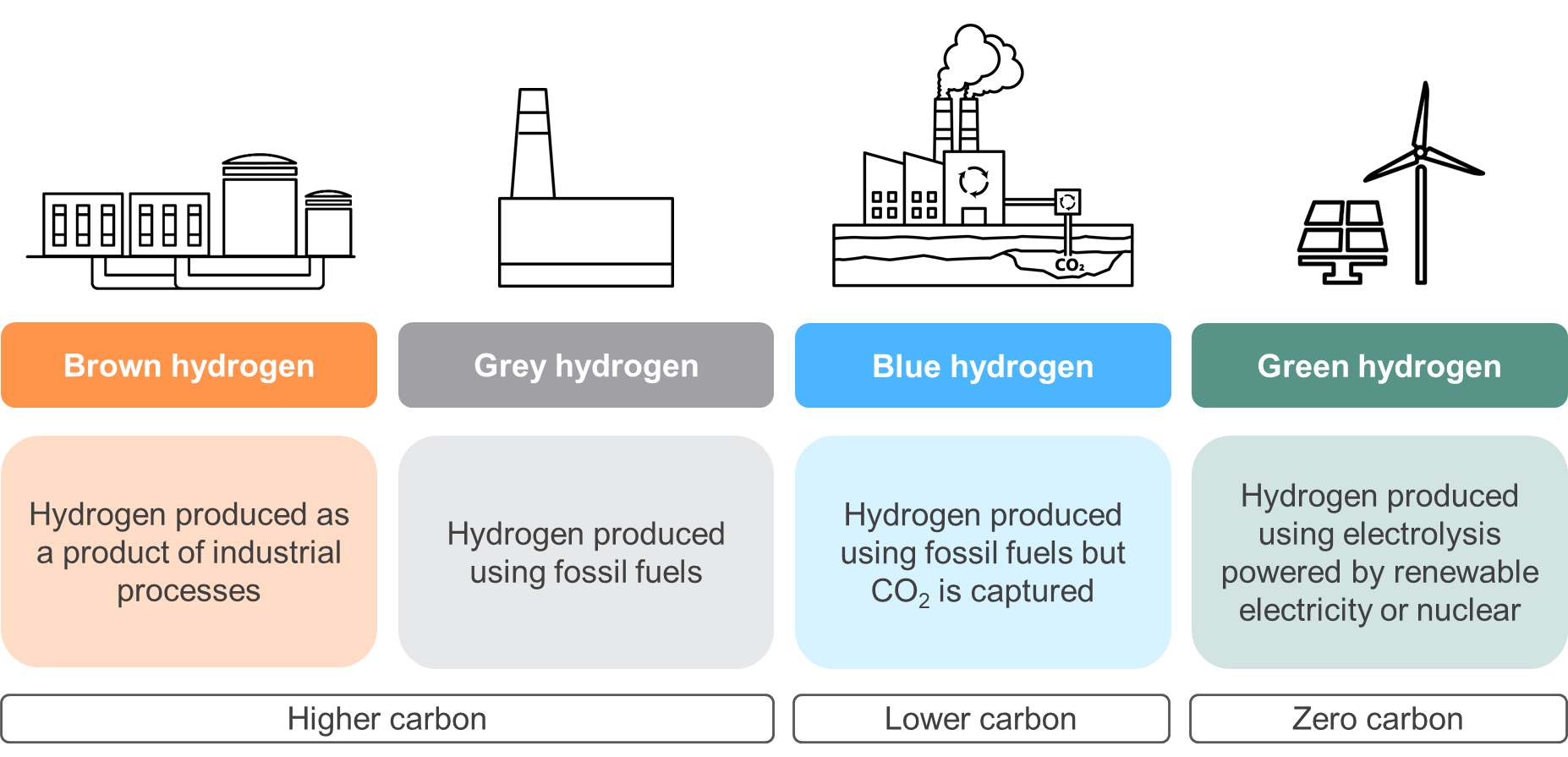Biodiversity & Environment
Green Hydrogen: Enabling Measures Roadmap for Adoption in India
- 16 Jan 2024
- 11 min read
For Prelims: Net Zero by 2070, United Nations Climate Change Conference in Glasgow (COP26), Gray Hydrogen, Fossil Fuels, National Green Hydrogen Mission.
For Mains: Green Hydrogen: Enabling Measures Roadmap for Adoption in India, Government policies and initiatives for green hydrogen.
Why in News?
Recently, the World Economic Forum along with Bain & Company has released a report titled- Green Hydrogen: Enabling Measures Roadmap for Adoption in India, highlighting that Green Hydrogen production cost needs to be reduced to less than or equal to USD 2 per kg.
What are the Key Highlights of the Report?
- India’s Demand for Energy is Set to Surge:
- India is currently the third-largest economy in the world in terms of energy needs, and the country’s demand for energy is set to surge – demand is estimated to grow 35% by 2030.
- In 2022, India's energy import bill reached USD 185 billion, which is likely to increase if the country continues to meet its growing energy demand through traditional methods.
- At the same time, India has set a commitment to achieve Net Zero by 2070 at the United Nations Climate Change Conference in Glasgow (COP26), held in 2021.
- India is currently the third-largest economy in the world in terms of energy needs, and the country’s demand for energy is set to surge – demand is estimated to grow 35% by 2030.
- Criticality of Green Hydrogen:
- Green Hydrogen is critical to help meet India’s energy security needs while reducing emissions in hard-to-abate sectors on the path to net zero.
- Recognizing this, the Indian government launched the National Green Hydrogen Mission in 2022.
- The aim is to spur green hydrogen production and consumption through roughly USD 2.3 billion in incentive funding, to be distributed between 2022 and 2030.
- Current status of Hydrogen Production in India:
- Currently, India produces 6.5 million Metric Tonnes Per Annum (MMTPA) of hydrogen, predominantly for use in crude-oil refineries and fertilizer production.
- Most of India’s current hydrogen supply is Gray Hydrogen, which is produced using Fossil Fuels in a process that creates CO2 Gas Emissions.
- Green Hydrogen production requires an ample supply of Renewable Energy for the electrolysis process.
- India’s renewable energy potential can support its goals for green hydrogen growth but needs rapid capacity addition – additional capacity is required to generate green hydrogen as well as to meet the country’s electricity needs.
- There is limited on-the-ground traction for green hydrogen in the country; most are in a “wait-and-watch” phase. Many expect sizable production of green hydrogen to take effect beginning in 2027 and after.
- Constraints in Green Hydrogen:
- Important constraints for the expansion of green hydrogen in India include, on the supply side, the cost of production and delivery, and, on the demand side, Indian players’ readiness to consume green hydrogen in traditional industrial processes.
What is the Blueprint proposed by the Report for the evolution of Green Hydrogen in India?
- Reduce the Cost of Producing Green Hydrogen:
- Green hydrogen today costs roughly USD 4–5/kg to produce in India, approximately double the production costs for grey hydrogen.
- The majority of production costs for green hydrogen (50–70%) are driven by the need for round-the-clock (RTC) renewable electricity.
- Green hydrogen needs to come down to a benchmark goal of USD 2/kg for a green energy ecosystem to develop in India. This can be done through:
- Increasing direct subsidies for early adopters – for example, the USA has announced, under the Inflation Reduction Act (IRA), a tax credit of up to USD 3/kg of hydrogen.
- Supporting long capital investment cycles for technologies with long-term clarity on policies and incentives
- Encouraging the development and testing of indigenous electrolyzer technology
- Green hydrogen today costs roughly USD 4–5/kg to produce in India, approximately double the production costs for grey hydrogen.
- Reduce Costs related to Green Hydrogen Conversion, Storage, and Transport:
- Despite low production costs, infrastructure expenses (conversion facilities, storage, and transport) can significantly affect the overall cost of green hydrogen and its derivatives.
- Minimizing the costs of establishing this infrastructure, will reduce delivery costs and increase offtake.
- Essential interventions to achieve this are
- In the short to medium term, developing green hydrogen production clusters where a collaborative environment for production and offtake occur in close proximity.
- Investing in long-term infrastructure construction, including pipelines for transporting green hydrogen throughout the country.
- For example, the European Union’s European Hydrogen Backbone programme aims to develop a pipeline network in the EU.
- Essential interventions to achieve this are
- Support Industries that are most likely to Adopt Green Hydrogen:
- Certain industries are better positioned than others to embrace green hydrogen consumption.
- Incentives, subsidies, and other support mechanisms should target likely adopters to increase India’s domestic demand for green hydrogen.
- Chief among these are existing grey hydrogen users. Stakeholders can support domestic green energy demand among users of grey hydrogen by increasing direct subsidies.
- This will reduce green hydrogen costs in the short term and encourage long-term demand for the new energy source.
- Certain industries are better positioned than others to embrace green hydrogen consumption.
- Capitalize on India's Export Potential:
- India has the potential to become a hub for green hydrogen derivative exports given its relatively low-cost renewable energy, skilled workforce, and abundance of land for renewable energy expansion.
- Stakeholders can capitalize on India’s export potential by improving export infrastructure at ports.
- Green hydrogen derivatives need to be converted at the production site or ports before they can be exported.
- Export also requires storage and shipping facilities at port terminals.
- Disincentivize Carbon-Intensive Energy Sources:
- In addition to incentivizing green hydrogen adoption, India must also disincentivize carbon-intensive energy sources.
- India can divert subsidies away from high-emission sources and redirect funds toward the green energy transition.
- A comprehensive carbon-tax regime could help India meet rising energy demand, without compromising energy affordability for the population.
What is Green Hydrogen?
- About:
- Hydrogen is a key industrial fuel that has a variety of applications including the production of ammonia (a key fertilizer), steel, refineries and electricity.
- However, all of the hydrogen manufactured now is the so-called ‘black or brown’ hydrogen because they are produced from coal.
- Hydrogen is the most abundant element in the universe. But pure, or the elemental hydrogen, is very scarce.
- It almost always exists in compounds like with oxygen to form water.
- But when electric current is passed through water, it splits it into elemental oxygen and hydrogen through electrolysis.
- Colors attached to hydrogen indicate the source of electricity used to derive the hydrogen molecule.
- Need for Producing Green Hydrogen:
- Hydrogen is a great source of energy because of its high energy content per unit of weight, which is why it is used as rocket fuel.
- Green hydrogen in particular is one of the cleanest sources of energy with close to zero emission.
- It can be used in fuel cells for cars or in energy-guzzling industries like fertilizers and steel manufacturing.
- Countries across the world are working on building green hydrogen capacity as it can ensure energy security and also help in cutting carbon emissions.
- Green hydrogen has become a global buzzword, especially as the world is facing its biggest-ever energy crisis and the threat of climate change is turning into a reality.
What are the other Initiatives Related to Renewable energy?
- Jawaharlal Nehru National Solar Mission (JNNSM)
- International Solar Alliance
- PM- KUSUM
- National Wind-Solar Hybrid Policy
- Rooftop Solar Scheme
UPSC Civil Services Examination Previous Year Question (PYQ)
Q. Consider the following heavy industries: (2023)
- Fertilizer plants
- Oil refineries
- Steel plants
Green hydrogen is expected to play a significant role in decarbonizing how many of the above industries?
(a) Only one
(b) Only two
(c) All three
(d) None
Ans: C
Q. With reference to green hydrogen, consider the following statements : (2023)
- It can be used directly as a fuel for internal combustion.
- It can be blended with natural gas and used as fuel for heat or power generation.
- It can be used in the hydrogen fuel cell to run vehicles.
How many of the above statements are correct?
(a) Only one
(b) Only two
(c) All three
(d) None
Ans: (c)
Q. Hydrogen fuel cell vehicles produce one of the following as “exhaust” (2010)
(a) NH3
(b) CH4
(c) H2O
(d) H2O2
Ans: (c)

.png)
.png)





